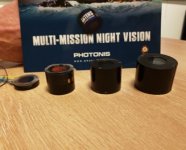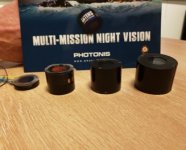So if you were following Eliteuas' thread, the first batch arrived this week and Fedex delivered it just in time for the new moon this Saturday!
First impression, they certainly nailed the presentation. It came in this massive SKB case and quite a few accessories including counter weights+ pouch, sacrifical filters, and more.
Coffee mug is for scale and not included...

The first thing you notice about the unit is definetly its size, I've played with many different NVGs/Housings (DTNVG/DTNVS, PVS31A, RNVG, and MOD3) and these are without a doubt the most compact unit Ive handled.
A quick comparison of size between a couple units

When I ordered the PD-PRO-Bs the intention was to do a direct comparision with a set of PVS-31As. Sadly I've since let go of the 31As, but did snap photos when I had them.


Note: its a cheap $10 kitchen scale, im not sure actual weight is accurate as its not certified, but am confident in it determining relative weight.
Getting into the nuts of it, went out with a couple of buddies last night during the new moon in woods. So there was no illumination except starlight. The photos were taken at places more than a few hundred yards away from artificial light. Photonis PD-Pro-B on the left and L3 24UA tubes (tubes were as nice as the ones in the 31As I had) on the right.
Buddy at about 50yrds


Buddy at about 25 yrds


Photos were taken with a Samsung Galaxy Note 20 Ultra. I did not tweak the settings, just selected the photo tab and snapped pics. This left the phone to select the appropriate setting. So with this in mind, the pics are slightly different from "to the eye" and of course its always hard to compare photos in general to "to the eye".
To the eye, the photonis set did not have as high of a gain as the L3 did; they appered not as "bright" side by side. So if you were to just go by this initial quick 5 sec look thru; many would say the photonis was just not as good.
But, although the photonis is not as bright, the level of detail/definition (which the photos illustrate) is not much lower. Like how eyes after a period of time adapts to the dark, the lower gain does not equate to far lower performance. I would describe the photonis set as similar in picture to tubes with manual gain turned down. While I can say L3 is still the best at low light performance, these photonis tubes doesnt seem to be far off. In high light of course thats where the photonis set shined.
I didnt take photos of high light enviroments, but in situations where the L3 was showing temp burns (thus I didnt want to hold the tube there to snap a pic) the photonis was chugging along just fine.
Final thoughts: These are the only set of binos I was able to fit into a Raine PVS-14 Padded case (31As included) or for that matter my pants pockets( which was kind of a "whoa!" moment). These are the only metal articulating binos option on the market and I've have no doubt, like RNVGs, they are built like a tank(yet lighter than 31As). So if stowability and ruggedness are important, these bino fit the bill. Horta was right lol. From a commercial standpoint If you live somewhere where the popuation density is meaured in miles, the nearest street lamp is not in view, its your first set of binos and all you want it pure low light performance; these are not for you. But for those who are in suburban or urban environments, I think these binos are great. Not to mention a Gucci bug out bag.
First impression, they certainly nailed the presentation. It came in this massive SKB case and quite a few accessories including counter weights+ pouch, sacrifical filters, and more.
Coffee mug is for scale and not included...

The first thing you notice about the unit is definetly its size, I've played with many different NVGs/Housings (DTNVG/DTNVS, PVS31A, RNVG, and MOD3) and these are without a doubt the most compact unit Ive handled.
A quick comparison of size between a couple units

When I ordered the PD-PRO-Bs the intention was to do a direct comparision with a set of PVS-31As. Sadly I've since let go of the 31As, but did snap photos when I had them.


Note: its a cheap $10 kitchen scale, im not sure actual weight is accurate as its not certified, but am confident in it determining relative weight.
Getting into the nuts of it, went out with a couple of buddies last night during the new moon in woods. So there was no illumination except starlight. The photos were taken at places more than a few hundred yards away from artificial light. Photonis PD-Pro-B on the left and L3 24UA tubes (tubes were as nice as the ones in the 31As I had) on the right.
Buddy at about 50yrds


Buddy at about 25 yrds


Photos were taken with a Samsung Galaxy Note 20 Ultra. I did not tweak the settings, just selected the photo tab and snapped pics. This left the phone to select the appropriate setting. So with this in mind, the pics are slightly different from "to the eye" and of course its always hard to compare photos in general to "to the eye".
To the eye, the photonis set did not have as high of a gain as the L3 did; they appered not as "bright" side by side. So if you were to just go by this initial quick 5 sec look thru; many would say the photonis was just not as good.
But, although the photonis is not as bright, the level of detail/definition (which the photos illustrate) is not much lower. Like how eyes after a period of time adapts to the dark, the lower gain does not equate to far lower performance. I would describe the photonis set as similar in picture to tubes with manual gain turned down. While I can say L3 is still the best at low light performance, these photonis tubes doesnt seem to be far off. In high light of course thats where the photonis set shined.
I didnt take photos of high light enviroments, but in situations where the L3 was showing temp burns (thus I didnt want to hold the tube there to snap a pic) the photonis was chugging along just fine.
Final thoughts: These are the only set of binos I was able to fit into a Raine PVS-14 Padded case (31As included) or for that matter my pants pockets( which was kind of a "whoa!" moment). These are the only metal articulating binos option on the market and I've have no doubt, like RNVGs, they are built like a tank(yet lighter than 31As). So if stowability and ruggedness are important, these bino fit the bill. Horta was right lol. From a commercial standpoint If you live somewhere where the popuation density is meaured in miles, the nearest street lamp is not in view, its your first set of binos and all you want it pure low light performance; these are not for you. But for those who are in suburban or urban environments, I think these binos are great. Not to mention a Gucci bug out bag.
Last edited:






